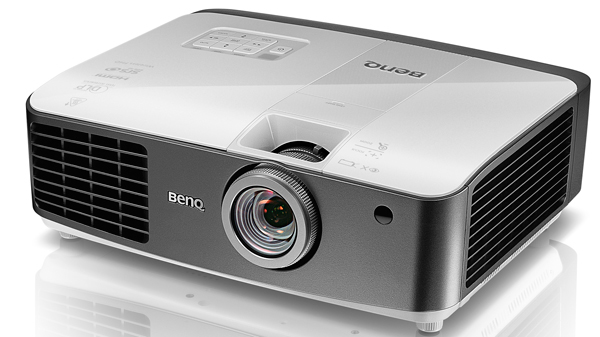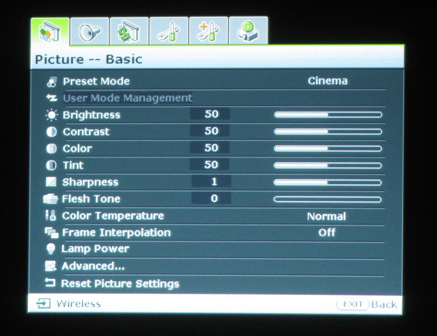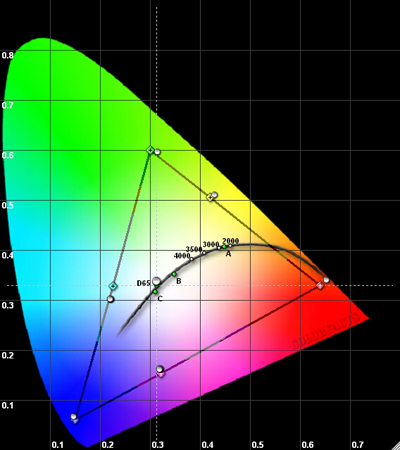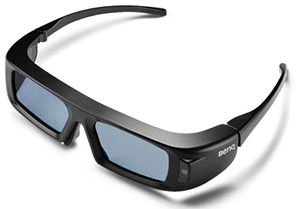One of the perceived drawbacks to buying and installing a front projector is the cost and hassle of running a long length of HDMI cable from the source equipment to the projector itself. Projectors are typically mounted on the ceiling or back wall which means they may be far away from your sources and you'll need to find a way to hide that cable away.
With BenQ's W1500 3D DLP projector, which features a 5 GHz wireless HDMI connection system, there's now no need to run a long HDMI cable to the projector. This can save potentially hundreds of dollars in HDMI cable and installation labor costs.
Included with the projector is a compact "dongle" transmitter that's roughly twice the size of your typical USB thumb drive. This transmitter plugs into the HDMI output of the source device or A/V receiver, and is powered by a wall wort AC power adapter. While there is a 5V rail that runs down the HDMI line, the amount of available current is simply insufficient to power the transmitter dongle, which communicates between the source device and the projector in the 5 GHz band, ergo the need for the AC power adapter.

The W1500 is a single chip DLP affair (BenQ claims to be the largest maker of DLP projectors in the world), and features a TI DarkChip3-based light engine.
It's also a 3D projector, and as with other BenQ 3D projector models, the W1500 uses active shutter LCD glasses that get its 3D sync signals right off the screen via Texas Instruments' DLP Link technology. Taking advantage of the very high speed of DLP imaging technology, the 3D sync pulses are mixed in with the alternating left/right 3D images so quickly that they're completely invisible to the viewer. I've found this approach to be superior to 3D projectors that use infrared sync active shutter technology, as it's all too easy to briefly look away from the screen and temporarily lose sync with IR glasses. As with other DLP Link-equipped 3D projectors I've tried, I didn't experience any sync loss with the W1500, even when I turned away from the screen momentarily.
The folks at BenQ seem to be aiming the W1500, at least partly, toward gamers and fans of mobile/transportable home theaters. The projector ships with a very well designed carrying bag that features a front pouch to store cables, the remote, the HDMI transmitter and power adapter, among other stuff, and it has nice touches such as secure straps to hold the projector in place. There's also a detachable (and adjustable) shoulder strap. The projector also has 2 built-in speakers (10W each), which I suppose are at least somewhat useful when there's no other audio solution around.
Given the projector's somewhat above entry level price point ($1,699 list, but street prices are around $300~$400 less) it's hardly a surprise that the projector doesn't come with fancy motorized optics (focus, zoom, lens shift). But, the W1500 has manual vertical lens shift, which gives a little wiggle room in placing the projector on, say, a coffee table without having to resort to digital keystone controls. However, the amount of vertical lens shift isn't much at all, reducing the portability factor by quite a lot, as either you'd need a very high coffee table, or a very low screen on the wall in order to use it as the picture on the company's website suggests. A permanent ceiling mount is probably a better choice.
Connectivity
In addition to the wireless HDMI input, the W1500 sports two additional HDMI inputs, and includes a VGA port that can also function as a component video input with a suitable adapter. There's a dedicated component video input, an S-video input and a composite video input.

Rounding out the impressive connectivity package is a stereo audio input via RCA jacks, another stereo audio input via 3.5mm jack, a 3.5mm stereo audio output jack, and a 12V trigger port. There's a USB mini-B port, but that's for service only. An RS-232 serial port is also included.
The Setup
To take advantage of the wireless HDMI feature, connect the dongle to the output of the source device (AVR, Blu-ray player, cable box, etc.), connect the power adaptor, and you're set. To see how far away from the projector the HDMI dongle could be placed, I rigged up a Blu-ray player on my outdoor patio table, along with the dongle and power adaptor, popped in a disc, pushed play, and went inside to see if the signal arrived intact at the projector (it did). The distance was about 30 feet, with the outdoor wall and an interior wall separating the devices. This should be more than enough distance for a typical home theater installation.
The configuration menus provide the usual projector placement options, and while I would have liked to have motorized optics to get the projector and the screen dialed in together, it wasn't too much of a hassle to use the manual focus and zoom adjustments.

While checking various initial settings with my HD test pattern generator, I noted that the sharpness control exhibited slightly odd behavior. At the minimum "0" setting there was some softness to the 1080p HD sharpness test pattern (not unusual at all). But, at the next setting up ("1"), there was some noticeable ringing, indicating at least some sharpness enhancement.
Drilling down further in the menu, I found another adjustment that BenQ calls "Clarity Control". That adjustment provides further sharpness enhancement or reduction. With the sharpness set to "1" and the Clarity Control set to "2", I was able to see a perfect 1080p HD image, with single pixels clearly delineated and with no discernable ringing (haloing).
Remote Possibilities
The remote is a mixed bag. It has so-called "aviation red" backlighting, which is good, and the main cursor keypad buttons (9 of them, in a 3x3 arrangement) are clearly marked. The rest of the buttons however, feature thin font labels that are almost unreadable without the backlighting, and only slightly more readable when the backlighting is on.
The remote features dedicated source selection buttons, and a separate source button that lets you scroll through all of the inputs. There are 3 user setting buttons, and dedicated buttons that take you right to the relevant picture control function without having to drill down through the main menu. All of these are useful to have.
The remote also features dedicated power on and power off buttons, which is great for programming a system remote with macros to start things up and shut them down.
On Screen Display
The on screen display won't win any awards for aesthetic design, as it is rather plain, but the submenus and their associated controls are logically grouped and easy to get to. Having dedicated picture tuning buttons on the remote means that once setup is done, you'll have little need to go to the OSD if you want to tweak the picture from time to time.
The menu box occupies only about 12% of the available screen area, and can be placed in any of the 4 screen corners as well as screen center.

But, when making picture adjustments, the menu box stays put, which is a bummer if you prefer to position it at screen center, as I do. With many other projectors (and TVs), when you select a picture control adjustment, the menu disappears temporarily and a slider bar graphic appears near screen bottom, letting you see the big picture while making adjustments.
Screen Brightness
There are 3 lamp modes: Standard, Economic and Smart Eco. The Standard setting has the W1500 putting out quite a bright image, enough to realize a suitably bright image with a large screen (130" diagonal).
The Economic mode drops light output, but even with a fairly large screen (100" diagonal), there's still enough light for a watchable image along with increased lamp life (up to 5,000 hours according to BenQ). The Smart Eco mode provides some dynamic light modulation according to picture content, with even longer lamp life of up to 6,000 hours.
The Analyzer Speaks
The W1500 is ISF Certified, which means two things. First, there has to be at least one picture mode that provides a combination of preset settings that delivers a good out-of-the-box picture, with proper color gamut, correct color temperature and gray scale, and good gamma. The W1500's Cinema setting provided the best results of the available choices.
While ISF Certification also means that the projector can be thoroughly calibrated by a professional, one has to wonder how many people will pay for a full-on calibration that can cost hundreds of dollars for a projector that sells for around $1,300. Still, the full suite of calibration controls are there for those that may want to use them.

The color temperature/gray scale linearity, with the Cinema mode chosen, delivered an excellent result, with a flat gray scale that hugged the desired D65 neutral color temperature across the entire luminance measurement range.
The gamma result was similarly very good. The 2.4 gamma setting delivered a 2.45 result, which is virtually spot on, and the RGB tracking was also very good.

2D Performance
One of my favorite go-to Blu-ray discs is Ron Fricke's Baraka, a sumptuous visual feast originally shot in 65mm anamorphic Todd-AO and re-mastered via 8K ultra high resolution scan. With the film's superb color palette and highly saturated colors, if the display doesn't hew very closely to the Rec.709 HDTV standard, it's all too easy for things to get out of hand and look cartoonish. The W1500 does a fine job with this disc, which should be in everybody's Blu-ray collection.
I also played a number of music clips from Ramsey Lewis' Legends of Jazz Showcase sampler album, which is another of my favorite go-to Blu-rays. Featuring a slew of jazz greats, the disc is great for evaluating skin tones, shadow detail and color saturation. Here the W1500 provided a natural-looking picture that included detailed deep blacks and excellent shadow detail.

Simply put, the W1500 delivers a stunning 3D image. With the animated Despicable Me Blu-ray, the 3D effect was excellent, with no visible flicker and no deterioration of detail as is often the case with passive polarized 3D. To see if the motion smoothing feature had any bad effect with 3D, I cranked it up to the max. Things smoothed out just fine, and I didn't notice any artifacts.
BenQ doesn't include 3D glasses with the projector however, and mysteriously they're not even offered on the company's web store.
With the review sample, BenQ sent a pair of their battery-powered 144Hz 3D DLP link glasses, but those are rather pricey, at around $115 a pop on Amazon. They've been superseded by a newer, rechargeable model (5J.J7L25.002), which goes for a much more reasonable $59 (again, available on Amazon, but strangely not offered on the company's web store).
If that's still a bit too pricey for you, then consider compatible 144 Hz DLP-Link 3D glasses offered by SainSonic, which are very reasonably priced at $22 each, and are rechargeable via USB to boot (I didn't bother to obtain a pair, but I noted that there are quite a few 5 and 4 star reviews of the product, a number of them specifically referencing compatibility with various BenQ 3D projector models, including the W1500).
I also ran through a number of 3D demo Blu-rays, specifically focusing on HDTV-originated 3D (not from film) and was highly satisfied with the results. As far as 3D is concerned, the W1500 certainly delivers the goods.
Turn Ons
Turn Offs
Final Thoughts
Compared to BenQ's entry level 1080p 3D DLP projector (the W1070, which goes for $899 at the BenQ US web store and on Amazon), the W1500 provides two upgrades. The wireless HDMI is obviously the key differentiator, and will appeal to those that don't want the hassle and cost of installing a long HDMI cable run to the projector. The other feature that differentiates the two is the vertical lens shift adjustment, but, as noted, it's rather limited in range.
Certainly, the W1500 delivers very impressive 2D and 3D images, notable for color accuracy and a flicker-free 3D experience that absolutely trounces what you get with passive polarized 3D.
Specifications:
Manufacturer's Contact Information:
BenQ America Corp.| Overall | |
|---|---|
| Value | |
| Performance | |
| Features/Ergonomics |